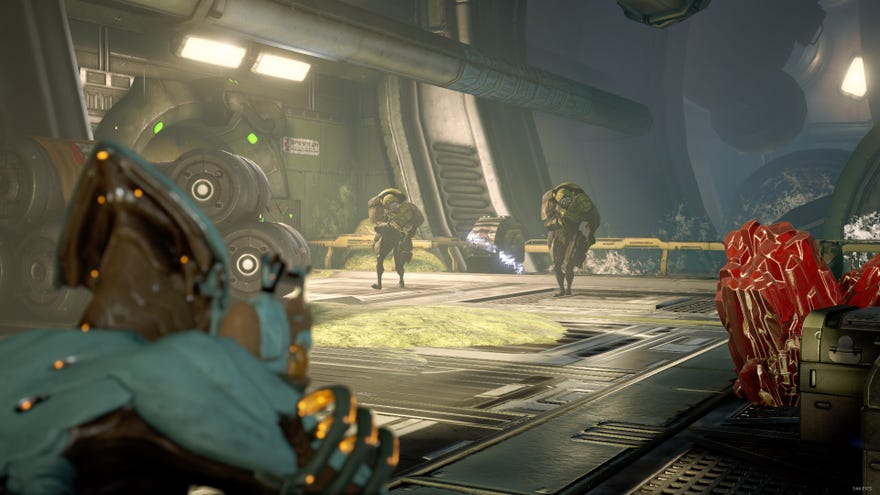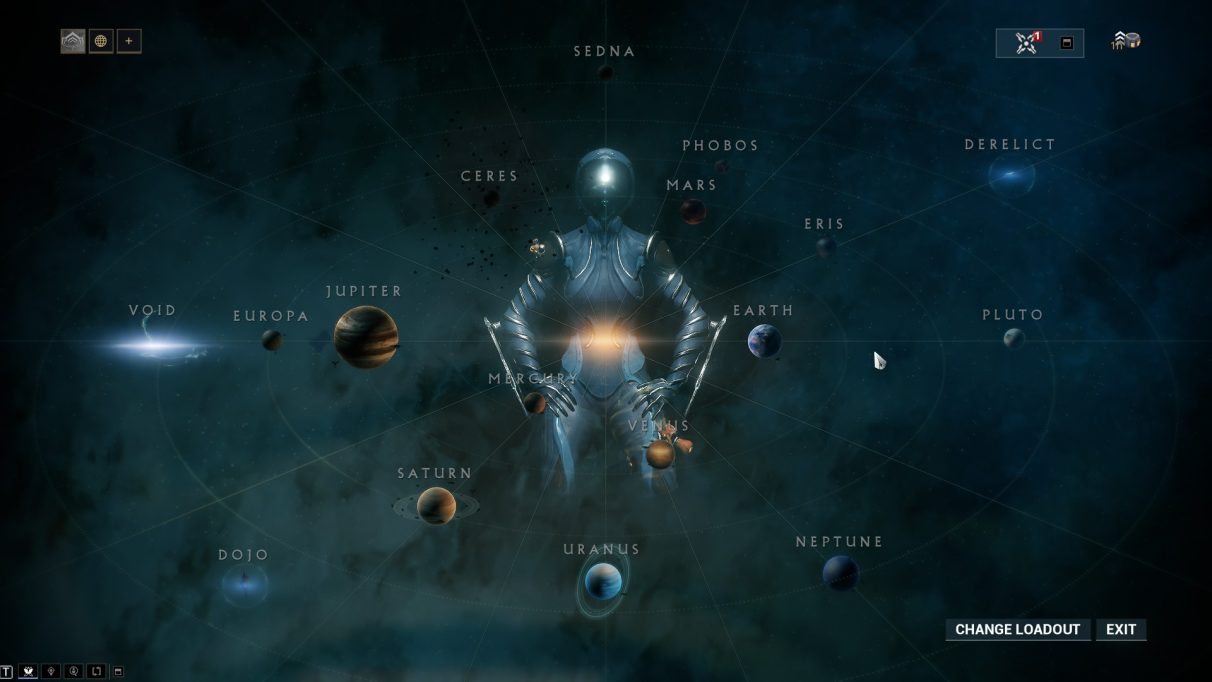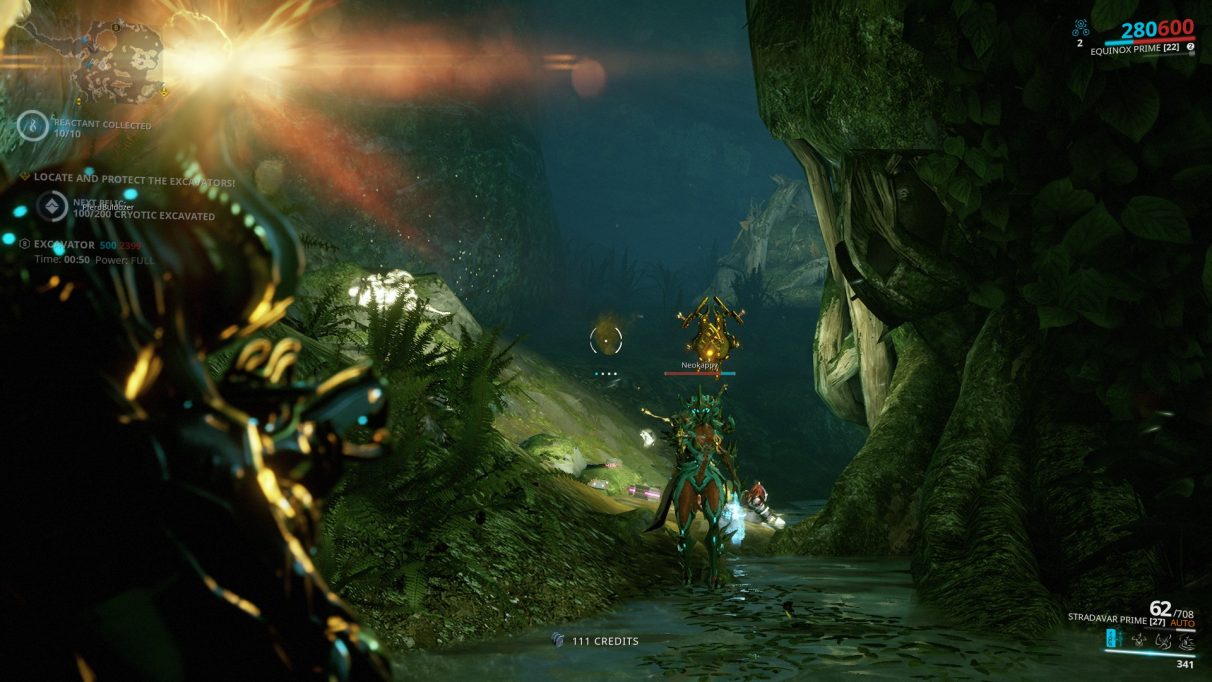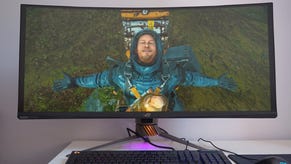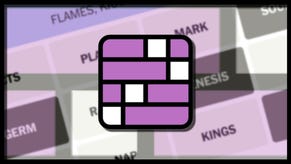Warframe guide - tips and tricks for beginners
Everything you need to know
Warframe is almost impressively obtuse; to the outside observer rather impenetrable. The free-to-play loot shooter has over five years of additions since its launch, layering system upon system upon system. All of which have an impressive amount of depth to them, but it is also almost aggressively uninterested in making sure newer players understand any of it.
There’s Warframes to mod, guns and swords and crossbows to craft in the Foundry, Dojo rooms to build, Endo and Mutagen Samples and Argon Crystals and, well, a whole bunch of other stuff. Like, a lot of other stuff, so be ready to grind, a lot. To help you on your journey into one of the biggest free-to-play loot games out there, we’ve got a bunch of tips and tricks for making your Tenno the best Tenno that it can be.
Warframe tips and tricks guide
Written by Taylor Cocke and Dave Irwin
This guide will be going over all of the things that beginners need to know before getting into the game, including some stumbling blocks you'll encounter, and some dedicated guides for each of the key systems found within.
Like any good loot game, Warframe is all about doing the same thing over and over again in order to get better and better stats. But unlike similar games, it’s not a linear progression. Rather than simply farm out the same item over and over again with the hopes of getting better and better stat rolls, Warframe is all about getting new gear and using mods to upgrade them.
Just in case you were wondering, the titular Warframes are effectively suits of armour that each has its own set of abilities (both active and passive), and stats. Whenever you change your Frame, you’re basically playing a new character class.
When you’re first starting out, don’t stress too much. Just get a feel for the movement, figure out what kinds of weapons you like, and generally just learn how the game operates. You won’t understand a lot about what’s going on, but thankfully Warframe is just a really good shooter in its own right. You don’t have to understand all the systems going on underneath the hood. You can read on for general advice, or hop over to one of the following pages if you're looking for something more specific.
- Warframe frames and mods - details on all the frames and how mods work.
- Warframe damage types - an explanation what each faction is weak against.
- Warframe Prime Relics - details on all the Prime gear available in the game.
- Warframe materials - find out the fast way to get credits and materials.
- Warframe Plains of Eidolon - all the features that appeared in the Remastered update.
- Warframe Fortuna - find out how to access the new update.
- Warframe GarudaWarframe Garuda - Everything you need to know to create the Fortuna update's 37th frame.
- Warframe Volt and Loki Prime - Where to farm Void Relics and materials needed to unlock Volt and Loki Primes.
- Warframe updates - List of all the latest updates to Warframe.
Nightwave Series 1
- Warframe Nightwave - Get all the latest on the current Nightwave event - including end times.
- Warframe Wolf of Saturn Six - Tips for how to defeat this rare assassin in missions.
Understanding the star chart in Warframe
All of Warframe’s missions are organised into a huge galaxy map called the Star Chart. You can look at specific missions and see which faction you'll be fighting against, which is useful for working out damage - more on that in our Warframe damage types guide. As you progress through the game, you’ll unlock more and more missions. Unlocking everything is key for having all the options necessary to get all the stuff you want. So, do that first. Unlock everything.
Remember to take a look at the Alerts in the top-right portion of the Star Chart. You’ll want to do a lot of those when you’re starting out, and later on for specific types of resources. Do all the Nitain Extract alerts. Just trust me on that one.
Why is this open-world story mission so hard?
I'll will admit that this one stumped me for the longest time and caused a lot of unnecessary frustration. If you have made it to either one of the open-world locations (Plains of Eidolon or Orb Vallis), you may find that the missions take a significant leap from relatively straightforward to nigh-on impossible. The reason why it was hard is honestly quite a dumb one, but hear me out on this one.
Normally, when you boot up a mission in any other game, the game will automatically balance the enemies accordingly to give the group a bit more of a challenge, compared to if they're doing it solo. It's likely that Warframe does this in the regular missions, but for some reason it doesn't when you load into one of the open-worlds.
To save yourself a huge amount of grief, or indeed if you are a maniac who wants a near insurmountable challenge, go to the menu screen aboard your ship. From there, you'll see your username and an icon of a globe. Click it and select from Public, Friends Only, Invite Only, or Solo. Solo is the option you'll want if you just want to make it through the story missions relatively unscathed. If you set it to public on purpose, get ready for the fight of your life.
How to get new gear in Warframe
When you first load up Warframe, you’ll be given a choice between three Warframes (Volt, Excalibur, and Mag), two melee weapons (a bo staff and a sword), two primary weapons (an automatic rifle and a bow), and two secondary weapons (a pistol and some kunai). It doesn’t matter which you choose, as you’ll be replacing most of them pretty quickly, so just pick up whatever you think is the coolest. The only note is that Volt is harder to farm up in the late game.
There’s a ton of ways to get new gear. First and foremost, you can buy certain weapons from the in-game Market. I’d recommend picking up a Braton for your primary weapon slot and the dual pistols Aklato for your secondaries relatively quickly, as they offer significant upgrades over your starter gear.
As you play through your first few hours of Warframe, you’ll find tons of resources and gear components. Typically, you’ll be able to use those resources with Market-purchased Blueprints to craft new gear in the Foundry. Crafting new gear usually takes somewhere between 12 (for guns and Warframe parts) to 72 hours (for full Warframes). You can rush the building process by paying Platinum, the real-world money option - this is a free-to-play game after all.
To craft Warframes, you’ll need to grab four components: Neuroptics, Systems, Chassis, and Blueprints. You’ll get those components a few ways, but most of your early Frames will come from farming bosses on specific planets. Mars boss Lieutenant Lech Kril, for example, drops the parts for Excalibur, so murdering him repeatedly will get you the ability to craft that Frame.
Other Warframes will come from a variety of other sources, including quest rewards, reputation bonuses, research in a Clan Dojo (we’ll get to Dojos later), and random drops off normal enemies (Oberon parts drop off of Eximus enemies, as an example).
Primary, secondary, and melee weapons operate similarly. Many weapon Blueprints can be purchased from the Market, but others have to be farmed or researched. Other gear can also be constructed in similar ways. There’s also Prime gear, which works a lot differently, so we’ll cover that in our Warframe Prime Relics guide.
Understanding Warframe's mastery ranks
Each and every piece of gear you use on your mass-murdering loot journey has its own level rank. As you play with them, they’ll level up, improving their stats and giving them more slots for installing mods (which we’ll get to in a second).
Every level you gain improves your Mastery Rank score, which is your overall account level. Raising your account level offers a bunch of benefits, not the least of which unlocking new gear. But it also gives all of your weapons a minimum amount of mod slots corresponding to your level, the ability to farm more reputation on a single day, the ability to hold more Void Traces (which you use for Relics, which we’ll get to), among a couple other things. Mastery Rank is important, but it’s not the end-all be-all. You’ll typically get it pretty passively if you’re just playing Warframe enough.
Once you’ve reached a new level, you’ll be asked to take a Mastery Rank Test, which you have to complete to advance. You’ll get one attempt every 24 hours at the test, so look up what you’re getting into beforehand. Most of them aren’t terribly hard, and you’ll continue gaining Mastery Rank points even if you don’t complete them, but you won’t fully rank up without finishing your exams.
Modding frames in Warframe
Once you’ve got your gear loaded, it’s time to power them up. Most of your power will come from the mods that you insert into your gear. Mods look like little cards that you can slot into your Warframes or weapons on the -- you guessed it -- mod screen. They do everything from giving you more shields or health, adding damage to your weapons or abilities, affecting your movement speed, or even some changes that only affect a very specific piece of gear. There are hundreds of mods in Warframe, and the mod screen can seem intimidating at first, but don’t stress too much.
Every mod has Capacity Drain, which tells you how much power it uses when installed into a piece of gear. Typically, the more powerful a mod is, the more capacity it drains. When you start off, your gear’s mod Capacity will be its item level. But there are ways to give you more capacity, including installing Orokin Reactors or Orokin Catalysts in Warframes and weapons, respectively, to double up your Capacity. Aura mods in Warframes and Stances Mods in melee weapons also give more Capacity.
See those little symbols on some of your mod slots? Those are Polarity symbols. Mods have them too. If you put a mod with a symbol into its a mod slot, the Capacity Drain of that mod will drop in half. Polarity management is a huge part of min-maxing your gear, so pay attention! Just don’t put the wrong Polarity in, that will increase the drain by 20%.
Mods themselves can be leveled up using Endo, one of the many, many resources in Warframe. Of course, each level increases a mod’s Capacity Drain. You can get Endo by doing the weekly Maroo’s Bazaar quest and selling your Ayatan Treasure reward back to Maroo herself -- but only after you put Ayatan Stars into it. That sounds complicated, but it’s pretty simple. You find Ayatan Stars out in the world, and they can be installed into Ayatan Treasures as an option on the mod screen.
Once you’ve figured out what you want to do with a particular piece of gear, customise it. Toy around with mods and see what you like. Or, head over to Warframe Builder to see what people have been doing with their gear.
See something you don’t have yet? Well, there’s probably a good reason for that. Some mods only drop off of certain enemies. Some are rewards for doing more difficult missions. Some of the most powerful ones are purchased from Baro Ki’Teer, a wandering merchant that pops up every so often a la Destiny’s Xur. Many of them are picked up purely by grinding out certain missions over and over again. Or, you know, you can buy them from the player-run market. For a more detailed rundown of mods, you can check out our Warframe frames and mods guide.
Some extra tips on mods
With the updates to our guides, we sometimes lose very useful comments. This is beyond our control, but there was a comment posted in our last update by the user "DrFunFrock" that I wanted to give its own space. So without further ado, I present his tips for mods. These won't be verbatim as the comment was incredibly long, but I'll bullet point the most relevant ones:
- Levelling mods is the most significant measure of your progress. Levelling them up is incredibly important. For example, the Serration mod adds 15% to the damage of any weapon you slot it into, but maxed out this increases to 165%. They're also reusable so you can put them into every weapon you own.
- Frame stats increase with level ups, but you should consider putting in mods that have been levelled up
- Frames ability damage isn't all that good typically, so you're relying on guns and swords to do the damage rather than spells. Just remember to equip the mods to it!
- Newer players should try and get the Rhino frame as soon as possible as it can temporarily make itself immune to damage.
- Focus on increasing raw damage of the weapons you modify.
- Add elemental mods as well to increase their levels.
- Don't focus on mods that increase individual parts of damage (impact, piercing and slash, or IPS). They're not worth the investment initially.
- Multi-shot is a good initial skill mod to have as it can vastly increase your bullet payload.
- Mods that increase fire rate for bows or pierce through multiple enemies can be useful for crowd control.
- Shred is a very good primary weapon mod that should be obtained and levelled up as soon as possible.
- Above all else, try to make friends with veteran players. They may have lots of spare mods they're dying to get rid of. Pop into region chat and ask politely if anyone will "taxi" you to the mission.
How to use Formas in Warframe
Once you get deep, deep into Warframe, Formas will become your best friend and biggest annoyance. Mostly, you’ll be using Formas to slap additional Polarities on your gear. Once you hit level 30 on a weapon or Warframe, you can hit it with a Forma to give one of its slots a new Polarity symbol, opening up even more Capacity. But once you do that, the weapon will lose all of its levels, making you level it up a second time to fully utilise your new Polarity slot. It’s a lot of work to properly Forma up your gear, so be sure you’re ready for the commitment if you’re going to go through the process.
Be careful, though. Formas are also used to craft certain pieces of gear, raise up in reputation ranks, or used to create rooms in Dojos. So don’t go spending them willy nilly. There are lots of ways to get Forma, such as obtaining Blueprints for them as rewards for certain missions (Alerts, Invasions, Orokin Derelicts, and some Orokin Voids, for example) or from Relics. From there, just like the vast majority of things in Warframe, you’ll have to craft them.
Warframe clans and dojos
Just like any good RPG, Clans are a big part of Warframe. Joining up for a Clan has a lot of benefits, but mostly it gets you the opportunity to research gear that can’t be attained anywhere else. First, you’ve got to build the various Lab rooms that unlock the ability to research new gear. Then, you’ve got to put in the resources to research gear. Doing this takes 72 hours per piece of gear. Then, you’ll buy the blueprints to actually build the things you want. It takes a while and costs a lot of resources, but it is entirely necessary if you want those blueprints.
For most solo players, paying the upkeep on a Dojo and researching everything on your own can get quite expensive. But if you have a group around you (or find one while playing), anyone can contribute to the research costs. That way, you can split up the cost.
Playing Warframe's Sorties
Sorties are as close to MMORPG-style raids as Warframe gets. Unlocked after completing The War Within quest, Sorties offer up three missions per day that must be completed in order. All three are more difficult versions of normal missions, culminating in a much more difficult version of a boss fight from the main game.
Each mission will have specific conditions that make them more difficult. Some will erase your shields, others require you to only use a shotgun or melee weapon, while still others will reduce your movement speed.
To pull off Sorties successfully, you’ll likely want to pull together a strong squad of four players with strong gear and good mix of DPS, crowd control, and tank Frames. A defensive or healer support Frame can help, too. In public matchmaking, consider running a Frame with strong crowd control like Vauban, just to make sure your team has the support needed to complete it.
Assuming you complete the Sortie, the rewards are strong. Most often, you’ll get an Ayatan Sculpture, but you can also pick up a powerful Riven mod or even a Legendary Core, which can be used to max out any mod you have for no cost. Make sure you hold onto that for something really important.
